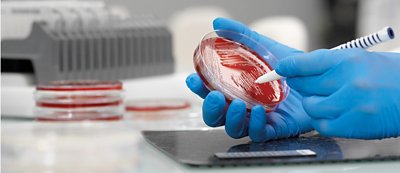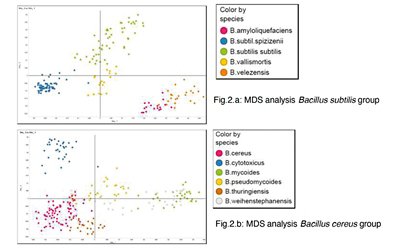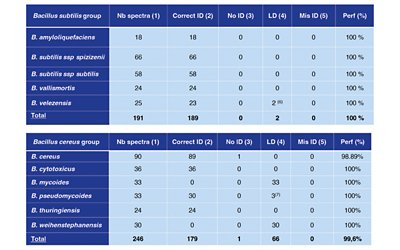The Value of MALDI-TOF Technology in Species-Level Identification

What is MALDI-TOF technology?
Matrix-assisted laser desorption ionisation (MALDI) uses a laser to absorb energy from a matrix to create ions with minimal fragmentation from large molecules. It can analyse biopolymers such as DNA, proteins, peptides, carbohydrates, and other organic macromolecules. In MALDI time-of-flight (TOF) mass spectrometry (MS), a TOF analyser measures the mass-to-charge (m/z) ratio of the charged molecules.
It is essential to identify and differentiate microbes when conducting tests to diagnose diseases, identify a source of contamination, or study the effects of treatments or environmental conditions on microbial populations. One of the most potent proteomics methods, MALDI-TOF MS, is a rapid, precise, and economical way to recognise and differentiate microbes, such as bacteria, viruses, parasites, and fungi. This technology produces specific mass spectra fingerprints unique to each microorganism and thus can identify them accurately at the genus and species level.1,2
MALDI-TOF MS compares spectra produced by intact cells to a fingerprint database in a simple and fast manner, making it ideal for use in a diagnostic laboratory setting. It develops databases of unique, conserved peaks which can be used to identify species and subspecies regardless of the culture conditions used to cultivate the microorganism.
Another feature of MALDI-TOF MS involves matching biomarker masses to a proteome database: proteins are the most observed biomolecules with a mass-to-charge ratio greater than 4000 m/z in MALDI-TOF spectra derived from whole-cell extracts. Therefore, an algorithm can predict protein masses from a sequenced genome and search for matches to experimentally derived masses. This bioinformatics-based approach is superior to bacterial fingerprinting, as it can identify microbes despite variations in protein profiles, culture growth, and sample treatment conditions. It can also detect microbial toxins and analyse antibiotic resistance.3-6
The importance of species-level identification in a pharmaceutical context
The gender of a particular organism is not an accurate indicator of its species. It follows that gender identification alone is no longer sufficient when assessing microorganisms due to the increasing complexity of microbial communities and their interactions with the environment. For the same genus of bacteria, one species may be extremely critical and another anecdotal. Microbial species identification enables the full investigation of root causes for contamination and supports pharmaceutical companies in their decision making. This approach aligns with the latest recommendations of the European Commission of Good Manufacturing Practice (GMP), as detailed in Annexe 1. The guidance states that all microorganisms found in the Grade A area (high-risk operations area, such as aseptic processing line) or Grade B area (a background cleanroom for a Grade A zone) are to be identified to their species, and their potential influence on product quality (for the respective batches) and production control should also be established. The guidance also advises that it is essential to identify and consider the microorganisms found in Grade C and Grade D areas (cleanrooms designated for less critical stages of the manufacturing process, such as solution preparation) when action limits or alert levels are exceeded, or after the isolation of organisms that could point to a decrease in control, a lack of cleanliness or which are themselves difficult to control, such as spore-forming microorganisms and moulds. GMP Annexe 1 can be found here .7
Essential advantages of MALDI-TOF technology
The MALDI-TOF technique can assess Gram-positive, Gram-negative, molds, mycobacteria, and anaerobic microbes, providing detailed information necessary to accurately identify bacterial contamination. Potential uses include early microbial detection on pharmaceutical or laboratory production lines. The MALDI-TOF technique can help prevent contamination along with the costly and time-consuming repercussions that contamination can bring, such as scrap and delays to production. A comparative study reported that MALDI-TOF technology reduced the time-to-result from 24 to 48 hours to less than 30 minutes. This enables microbiological controls to be addressed very quickly, thus improving decision-making in microbiological investigations carried out by the pharmaceutical industry.
MALDI-TOF technology can also detect multiple contaminations in one single sample, eliminating delays with no increase in cost or extra steps in the process: MALDI-TOF enables testing autonomy and expense reduction via internalised identification. A comparative study estimated that MALDI-TOF identification required an average time of 6 minutes for an approximatively 70 to 80% reduced cost versus conventional methods. An alternative, such as nucleic acid-based methods, is expensive, time-consuming, and less practical than MS for regular laboratory recognition and analysis.14-16
MALDI-TOF technology and the VITEK® MS PRIME
bioMérieux has over 50 years of microbiological expertise and has used this knowledge to develop an automated MALDI-TOF system that meets the challenges of microbiological quality control. Both the laser and the firing method have been perfected to guarantee species identification of microorganisms.
Our robust database, featuring intra-species diversity, facilitates an enhanced species identification performance, including Escherichia coli, Pseudomonas aeruginosa, Candida albicans, and Aspergillus brasiliensis. Our latest enhancement to the database focuses on moulds, mycobacteria and many critical bacterial species, adding 286 further species for 186 bacterial and 107 fungal species. The calculation algorithm has also been reworked to enable differentiation between closed species such as Bacillus cereus and Bacillus thuringiensis.
The VITEK® MS PRIME database now enables the identification of 1,585 species, including 16,000 unique strains of bacteria, yeasts, and moulds within minutes. With an average of 12 strains per species and enhanced workflow efficiency, the VITEK® MS PRIME ensures accurate and robust species identification.
The structure of our database enables us to achieve improved species identification performance for a critical pharmaceutical group: a study using MALDI-TOF MS to differentiate the Bacillus cereus and Bacillus subtilis groups reported high accuracy in differentiating between these close species without any extraction step. The database used in this study comprises 2,745 reference spectra from 117 species among the genus Bacillus and related species. No other MS system can differentiate these species in routine testing.

It appears that all species within the Bacillus subtilis and Bacillus cereus groups are easily distinguishable, except for Bacillus weihenstephanensis and Bacillus mycoides in the Bacillus cereus group, which overlap.

The VITEK® MS PRIME algorithm enables accurate discrimination of all species within the Bacillus cereus and Bacillus subtilis groups, with performance ranging from 98 to 100%, and confirms the close relation between Bacillus weihenstephanensis and Bacillus mycoides with relatively low discrimination.
References:
1. Croxatto A, Prod'hom G, Greub G. Applications of MALDI-TOF mass spectrometry in clinical diagnostic microbiology. FEMS Microbiol Rev. 2012;36(2):380-407. doi:10.1111/j.1574-6976.2011.00298.x
2. Alizadeh M, Yousefi L, Pakdel F, et al. MALDI-TOF Mass Spectroscopy Applications in Clinical Microbiology. Adv Pharmacol Pharm Sci. 2021;2021:9928238. Published 2021 May 7. doi:10.1155/2021/9928238
3. Pineda FJ, Lin JS, Fenselau C, Demirev PA. Testing the significance of microorganism identification by mass spectrometry and proteome database search. Anal Chem. 2000;72(16):3739-3744. doi:10.1021/ac000130q
4. Carbonnelle E, Beretti JL, Cottyn S, et al. Rapid identification of Staphylococci isolated in clinical microbiology laboratories by matrix-assisted laser desorption ionization-time of flight mass spectrometry. J Clin Microbiol. 2007;45(7):2156-2161. doi:10.1128/JCM.02405-06.
5. Alam SI, Kumar B, Kamboj DV. Multiplex detection of protein toxins using MALDI-TOF-TOF tandem mass spectrometry: application in unambiguous toxin detection from bioaerosol. Anal Chem. 2012;84(23):10500-10507. doi:10.1021/ac3028678
6. Idelevich EA, Sparbier K, Kostrzewa M, Becker K. Rapid detection of antibiotic resistance by MALDI-TOF mass spectrometry using a novel direct-on-target microdroplet growth assay. Clin Microbiol Infect. 2018;24(7):738-743. doi:10.1016/j.cmi.2017.10.016
7. EU GMP ANNEX 1. Manufacture of Sterile Medicinal. https://www.gmp-compliance.org/guidelines/gmp-guideline/eu-gmp-annex-1-manufacture-of-sterile-medicinal-products. Accessed April 27, 2023.
8. Labandeira-Rey M, Couzon F, Boisset S, et al. Staphylococcus aureus Panton-Valentine leukocidin causes necrotizing pneumonia. Science. 2007;315(5815):1130-1133. doi:10.1126/science.1137165.
9. Bizzini A, Jaton K, Romo D, Bille J, Prod'hom G, Greub G. Matrix-assisted laser desorption ionization-time of flight mass spectrometry as an alternative to 16S rRNA gene sequencing for identification of difficult-to-identify bacterial strains. J Clin Microbiol. 2011;49(2):693-696. doi:10.1128/JCM.01463-10
10. Böhme K, Fernández-No IC, Barros-Velázquez J, Gallardo JM, Cañas B, Calo-Mata P. Rapid species identification of seafood spoilage and pathogenic Gram-positive bacteria by MALDI-TOF mass fingerprinting. Electrophoresis. 2011;32(21):2951-2965. doi:10.1002/elps.201100217
11. Veloo AC, Welling GW, Degener JE. The identification of anaerobic bacteria using MALDI-TOF MS. Anaerobe. 2011;17(4):211-212. doi:10.1016/j.anaerobe.2011.03.026.
12. Fernández-Olmos A, García-Castillo M, Morosini MI, Lamas A, Máiz L, Cantón R. MALDI-TOF MS improves routine identification of non-fermenting Gram negative isolates from cystic fibrosis patients. J Cyst Fibros. 2012;11(1):59-62. doi:10.1016/j.jcf.2011.09.001
13. Bille E, Dauphin B, Leto J, et al. MALDI-TOF MS Andromas strategy for the routine identification of bacteria, mycobacteria, yeasts, Aspergillus spp. and positive blood cultures. Clin Microbiol Infect. 2012;18(11):1117-1125. doi:10.1111/j.1469-0691.2011.03688.x
14. Seng P, Drancourt M, Gouriet F, et al. Ongoing revolution in bacteriology: routine identification of bacteria by matrix-assisted laser desorption ionization time-of-flight mass spectrometry. Clin Infect Dis. 2009;49(4):543-551. doi:10.1086/600885.
15. Kajiwara H, Murakami R. Application of RT-PCR and MALDI-TOF MS for the detection of RNA luteovirus. Anal Biochem. 2017;539:45-47. doi:10.1016/j.ab.2017.10.003.
16. Khodadadi E, Zeinalzadeh E, Taghizadeh S, et al. Proteomic Applications in Antimicrobial Resistance and Clinical Microbiology Studies. Infect Drug Resist. 2020;13:1785-1806. Published 2020 Jun 16. doi:10.2147/IDR.S238446.


